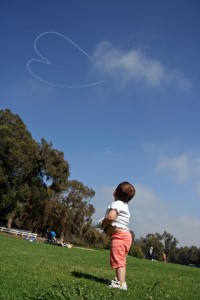
The sky is not the limit; it is the opportunity for serious mass advertising. The success of banner ads and skywriting prove that. A banner ad is a streamer or billboard dragged behind an airplane over a large gathering of people. Skywriting, on the other hand, contains no printed material. The plane actually writes the message with smoke on the canvas of the sky.
Skywriting is done by injecting a paraffin oil into the exhaust of the airplane, causing a white smoke to form. When this is done at strategic times, then the result is forming letters and thus a message for all below to read. The letters are huge, a mile tall, and written somewhere from 7000 to 17,000 feet altitude.
A unique form of skywriting is called, among other things, skytyping. Five or six planes fly in unison over the selected area. A computer on the lead plane decides when each plane is to make smoke and for how long. The result is a series of dashes in a straight line. When viewed from the ground, these dots or dashes of smoke together form parts of letters and eventually an entire word or sentence, much like the dots on a computer screen form a word or picture.
Skywriting and skytyping each have their pluses and minuses. One advantage to skytyping is that the message is made much quicker. A skywriting pilot can form a letter in 60 to 90 seconds while only a few seconds are needed with skytyping. This means the entire message is still visible for several minutes after it is finished. The length of time needed for skywriting means the first letters probably have drifted away by the time the message is finished.
Skywriting demands a skilled pilot who can maneuver a plane in every direction. He must also be somewhat of an artist to make the message uniform so it can be read. The skytyping pilots only need to fly in a straight line. The computer does all the deciding when to make the white smoke.
Because skywriting only needs one or two planes, the cost is less than hiring a whole fleet of planes to make one message. Geico insurance has made the skytyping their name against the sky famous.
Both methods have things in common. First, the preparation is simple. No need for printing or color design is necessary. The skywriting pilot plans how to write his message backwards so the people below see it frontwards. The skytyping pilots simply enter the message in the computer and let it do the work. Second, the message in both cases is environmentally friendly. The paraffin smoke is harmless to nature.
Skywriting, skytyping, and aerial advertising have something in common as well. All of them use the canvas of the sky, presenting their message to an audience without competition. Dollar for dollar on skywriting costs, advertisers are learning that this is an effective way to make their message known.